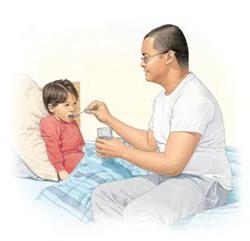A child’s rotavirus infection sometimes becomes a real “test of strength” for children and parents: it is so difficult to tolerate and accompanied by the appearance of several syndromes that aggravate it, it is sometimes difficult to understand where to start treatment.

The disease usually appears in children of a younger age group, it is harder to tolerate by babies 1-3 years of age. The virus is transmitted through dirty hands, when eating food from the same dishes with the patient, when playing with only toys, after which hands are not washed. You can get infected by drinking unboiled water, less commonly dairy products. Adults are especially dangerous as “distributors”: they hardly get sick or their disease manifests itself only in catarrhal phenomena, but they actively spread the virus into the environment. It is also quite simple to get infected from a child or an adult whose diarrhea is not particularly pronounced, but the virus is released into the environment with feces up to two months or more.
Rotavirus infection in a child manifests itself after a sufficiently short incubation period from 12 hours to 2 days.
In most children, the disease begins like this:
- body temperature rises, usually to high rates, which is quite difficult to bring down;
- a runny nose appears, there may be redness and sore throat;
- headache, refusal of food, weakness;
- vomiting occurs, which is repeated 2-3 times in a few hours, then it becomes less common;
- diarrhea appears: stools of usual color, liquid, fetid, often foamy, sometimes with a small admixture of blood. When a rotavirus infection develops in a child, stool can occur up to 20 or more times a day, leading to fairly rapid dehydration of the body without proper therapy.
Perhaps a different combination of symptoms and their appearance in time. So, the first signs of the disease can become a runny nose and cough, then vomiting and diarrhea develop . The disease can occur only with vomiting and completely without catarrhal phenomena; diarrhea can be of different frequency (from 3-4 to 20-30 times a day) and duration (2-3 days or longer). It is possible to develop a relapse of the disease, when the baby's condition has only just begun to normalize, but suddenly the temperature rises again, vomiting or diarrhea appears. Therefore, it is important to treat the disease together with an infectious disease doctor, follow all its recommendations and not rush to expand the diet.
How is the diagnosis made? Is it possible to diagnose at home?
Rotavirus infection tests can be done at home. This will help you distinguish it from a bacterial intestinal infection. To do this, you need to buy a Cito Rota Test (company test) at the pharmacy and perform it according to the instructions, taking a little stool of the child from a clean pot in which he did not mix with urine. Two bars indicate that the child has a rotavirus infection.
What to do if a child develops rotavirus infection?
- Do not panic, contact an infectious disease specialist.
- Buy at the pharmacy: “Acetone-test”, “Laferobion” candles of 500 thousand units (for children over 2 years old) or 125 units - for those younger, about 10 bags of “Humana Electrolyte”, several bags of “Smecta” or “White coal” in powder, “Bifilact-Extra” - 1-2 plates or a package of “Enterogermins”, candles “Cefecon” and syrup “Nurofen” or “Efferalgan”.
- Actively drink the baby. He should drink at least his daily norm (for example, for a child weighing 10 kg - this is about 1 liter of liquid), plus he should be given the liquid that he already lost with diarrhea, vomiting and fever, plus the one that he continues to lose.
You need to drink it with rice broth, water, in which "Humana's Electrolyte", chamomile broth is dissolved. It is also advisable to give up to 50 ml of Borjomi per day, from which gas has been previously released.
- "Smecta" or "Coal" - in an age dosage of 4-5 times a day.
- Suppositories "Laferobion" or "Viferon" - into the rectum at an age-specific dosage.
- We actively measure acetone in the urine and monitor its amount. Urine should be no less than 2 ml / kg / hour, and the level of ketone bodies, checked by a litmus test from the Acetone test, should be one “+” or “0”.
- We knock down the temperature with Tsefekon candles (or Efferalgan), syrup, rubbing with cool water and alcohol. It is important to ensure that you do not exceed the daily dosage of the drug.
If you see that:
- the child is sleepy;
- loses a lot of fluid with diarrhea or vomiting;
- you cannot lower the temperature;
- it is impossible to drink the baby due to constant vomiting;
- urine acetone is greater than "+";
- there were convulsive jerking of limbs, -
call an ambulance and go to the infectious diseases hospital.
Those mothers whose children had a rotavirus infection leave quite negative reviews: a very small number of parents were able to cope with the disease at home, many needed hospitalization, some children ended up in the intensive care unit for 1-3 days. Given all this, I want to say: after seeing diarrhea in a baby, do a company test. If he is positive, do not expect complications, go to the infectious diseases hospital, the child will feel good - you will leave, no one will keep you. But you will receive medical care and will be warned about what the next time to pay attention in the first place.